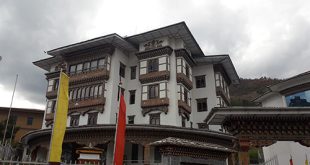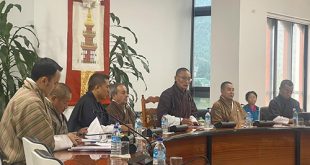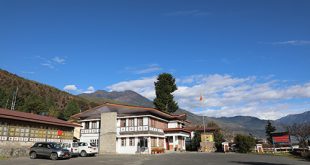During the 2023/24 General Elections, there is a PDP campaign video of the PDP President, Dasho Tshering Tobgay, talking about the proposed Economic Stimulus Plan (ESP) to a small Zomdu.
He asks the audience how the nation’s economy will recover, and gives the answer himself saying, through the ESP.
Dasho Tshering Tobgay said, “However, in 2013 the ESP amount of Nu 5 billion (bn) was enough, but this time around, the economic situation is much worse, and Nu 5 bn will not be enough, and so we need Nu 15 bn. If we put this Nu 15 bn through the Financial Institutions into the economy then the businesses will naturally revive, and we will be able to fix the economy.”
“These days, be it farmers, business people, students or professionals, they are all looking for loans to do work but loans are not available. This ESP will ensure that they get loans,” he added.
He said that farmers and business people unable to pay loans due to no work, and the economic downturn will also be helped through the ESP.
“The ESP will also be used to give a variety of important loans for small businesses, tourism related sector, farmers, taxi drivers, truck drivers,” said the PDP President.
He said that apart from loans the red tape also needs to be reduced as it hampers work.
What the PDP Manifesto says
Not only this, the PDP’s Manifesto in 2023 also talks about the ESP.
It says PDP shall promptly mobilize Nu 15 bn immediately upon assuming government leadership, and utilize this stimulus fund to facilitate the achievement of the macro-economic goals.
To execute this initiative effectively, a dedicated Stimulus Plan Task Force will be established to craft a comprehensive plan and oversee its implementation.
It says the stimulus fund will be used in the following areas, including but not limited to, provide loan deferment support and introduce special loan schemes tailored for businesses that are yet to fully rebound from the adverse impacts of COVID-19 pandemic in consultation with RMA.
It says ESP will establish and execute programs initiated by the Economic Development Board (EDB), establish downstream industries essential for supplying goods and services to hydropower development, and the 13th Five-Year Plan and accelerate the establishment and up-scaling of start-ups and Cottage and Small Industries (CSIs).
The ESP will promote and support export businesses and import-substitution enterprises, promote and support domestic manufacturing enterprises and inject liquidity into the Financial Institutions in consultation with RMA.
It said the ESP will introduce special measures to support women entrepreneurs, youth entrepreneurs, farmers, CSIs, film and entertainment industry, construction sector, IT sector, tourism sector, hotels and restaurants and the public transport sector.
Difference with ESP of today
However, the ESP of today, while incorporating several of the points above, also leaves out certain sectors.
While the PM promised loans for small businesses, tourism related sector, farmers, taxi drivers, truck drivers and those unable to pay loans due to business down turn, the ESP loans are only for Agriculture and Livestock and Production and Manufacturing by Cottage and Small Industries and Medium Industries.
Sectors like tourism, trading sector, services, taxi drivers and truck drivers were left out, and all those unable to pay loans with pending Non Performing Loans (NPLs) got left out of the ESP entirely.
More importantly, as promised by the PM, the entire Nu 15 bn was not pumped into Financial Institutions for loans, but only Nu 5.3 bn was given with Nu 3.3 bn as Concessional Credit and Nu 2 bn as the Reinvigoration Fund.
When it comes to the manifesto aspect of the ESP, the promises of loan deferment support, executing programs initiated by the Economic Development Board (EDB), downstream industries essential for supplying goods and services to hydropower development, establishment and up-scaling of start-ups and injection of liquidity into the Financial Institutions (FIs) did not happen.
There are also no special measures to support women entrepreneurs, youth entrepreneurs, construction sector, IT sector, hotels and restaurants and the public transport sector.
The question to ask is, why was there such a major difference between the ESP promised in the manifesto and the elections and the ESP that was finally implemented.
Why the difference
A senior official said that on the first day of the government, the Prime Minister issued 5 executive orders and 10 directives.
The third executive order was on the establishment of a high-level task force to formulate the implementation plan for the 15 bn Economic Stimulus Plan. The high-level task force was chaired by the Royal Monetary Authority (RMA) Governor and had the Finance Secretary, Ministry of Industry Commerce and Employment Secretary, ESP Director and some technical people like economists.
The official said it was this committee that gave the final shape to the current ESP which the government accepted.
On why the entire amount was not pumped into FIs as promised, the senior official said the committee wanted to balance between monetary measures (FIs) and fiscal measures.
The official said that the committee looked at the entire spectrum of the extreme left to the right. One option was implementing it like in developed economies where money is given directly in the accounts of people to increase demand an stimulate the economy.
However, the official said the problem was that since Bhutan’s economy was import dependent, the money, in no time, would reach India and only create pressure in the reserves.
The decision was also taken to leave out large industries as it was felt such projects would take a long time, and hence the impact would not be there.
The official said that it was also not feasible to put the bulk of money in agriculture as it is only 16 percent of the GDP and cannot generate jobs like Cottage and Small Industries (CSI) and Medium Scale Industries.
The choice was then decided to go for a mixed combination of loans and governmet programs under the ESP.
Why hotels and trading got left out
A major criticism was on why tourism was left out of the ESP loans given how badly the sector was hit during and after the pandemic.
The official said an economic analysis was done, and it was felt tourism did not need loans as there was already an oversupply of hotels, and the real problem was the number of tourists and so Nu 1 bn was put in tourism to develop tourism products and infrastructure that would help get the guests.
He said that hotels during pandemic were kept as quarantine centers to support them, and in fact, the biggest pandemic expense were these hotels. He said then there was loan deferment and many hotels still get the loan deferment, and so there was no shortage of monetary measures. The official said the aim is to get 300,000 tourists a year, and if the average stay is 5 nights, then there would be Nu 1.5 mn nights a year resulting in 60 to 70 percent occupancy rates.
Now, the Ministry of Industry, Commerce and Employment (MoICE) has put a proposal to the cabinet to include hotels in the Reinvigoration Fund of 4% interest.
On why the trading sector was left out, the official said the traders don’t need investment but only working capital to import goods and there is no real value addition.
The official said the CSI and medium production and manufacturing covers a variety of sectors like handicrafts, etc.
Support for Agriculture, Skilling, Youth employment, Entrepreneurship
The official said, “Nu 5.3 bn was given in ESP loans and on top of that Nu 1.5 bn is being given for housing loan (4%) and Nu 600 mn as Education Loan which means the total loan is actually going to be Nu 7.4 bn which is 50% of the total ESP.” Of the Nu 600 mn Education Loan, there have already been 300 recipients.
The official said that for farmers, apart from the loans, there is Nu 1.5 bn in Agriculture and Livestock Business Development where there is price guarantee support in buying 6 crops of rice, corn, buckwheat, corn, wheat and quinoa and three livestock meat of chicken, fish and pork. The official said the above program is already running with FMCL and BLDCL buying the products and giving farmers a ready market that includes cost price and some profit margin.
Of the Nu 1.5 bn, Nu 500 mn has been released for FMCL and BLDCL to develop the infrastructure and facilities for the aggregation. Another Nu 229.76 mn has been spent to buy crops and livestock from farmers.
The official said on top of that, there is another Nu 1 bn through One Gewog One Product (OGOP) where again farmers are encouraged to grow certain products for export, and there is a ready market for them.
The official said the ESP has to also help unemployed youth and these youths are not capable of taking loans, and so for them, the Nu 2 bn Desuung Skilling Program will allow them to get training and skills, and they can then be hired.
He said another group are those who are out of schools and colleges are without jobs and cannot fend for themselves, and this is where the YELP program with Nu 770 mn comes in. He said there are youths doing internship or work through YELP and getting paid.
To help entrepreneurs, there is Nu 600 mn which is being implemented by the Department of Entrepreneurship and Employment where entrepreneurs are being helped.
There is Nu 530 mn allocated for the Creative Industry and Nu 100 mn for CSI development.
Nu 100 mn had been kept for the expenses of the ESP secretariat like salaries of contract staff, vehicle and other expenses. So far, Nu 15 mn has been spent.
The official said politicians were getting worked up as some people were not getting the ESP loans, and this was bound to happen as there is limited money and many applicants, and whoever applied is not guaranteed to get loans.
He said those who get it stay silent, and those who do not get it make noise. The official said some of the loudest complaints have been from ones with NPLs which automatically disqualified them. He said people have to have credit worthiness to take ESP loans.
The official said there were demands from some to make the ESP list public, but this is private information that cannot be shared under the FSA Act.
The official said when USA was pressurizing Bhutan on the issue of visa overstayers, Bhutan asked for the list of Bhutanese overstaying and the US government flatly refused the information saying it would be a breach of privacy.
The official said it is more profitable for the government to give loans, as the loans will come back to the government, but in the case of grants based programs, it actually benefits the people with the money not coming back.
Private sector says no consultation
The Bhutan Chambers for Commerce & Industry (BCCI) President, Tandy Wangchuk, said the Nu 15 bn ESP was meant to boost the economy, but the BCCI was never consulted both for the initial committee and the current ESP Steering Committee.
He said of the Nu 15 bn, only Nu 5.3 bn was given for credit and of the remaining Nu 9.7 bn, one or two bn could have been kept for the government’s pledges, and as far as long-term developmental activities are concerned, the 13th FYP was already there.
The BCCI President said the rest should have been pumped in without discriminating against any sector as everyone is affected.
He said the three ESP loan areas of agriculture, production and manufacturing is not adequate.
 The Bhutanese Leading the way.
The Bhutanese Leading the way.




